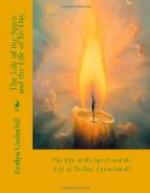First, there is the profound sense of security: of being safely held in a cosmos of which, despite all contrary appearance, peace is the very heart, and which is not inimical to our true interests. For those whose religious experience takes this form, God is the Ground of the soul, the Unmoved, our Very Rest; statements which meet us again and again in spiritual literature. This certitude of a principle of permanence within and beyond our world of change—the sense of Eternal Life—lies at the very centre of the religious consciousness; which will never on this point capitulate to the attacks of philosophy on the one hand (such as those of the New Realists) or of psychology on the other hand, assuring him that what he mistakes for the Eternal World is really his own unconscious mind. Here man, at least in his great representatives—the persons of transcendent religious genius—seems to get beyond all labels. He finds and feels a truth that cannot fail him, and that satisfies both his heart and mind; a justification of that transcendental feeling which is the soul alike of philosophy and of art. If his life has its roots here, it will be a fruitful tree; and whatever its outward activities, it will be a spiritual life, since it is lived, as George Fox was so fond of saying, in the Universal Spirit. All know the great passage In St. Augustine’s Confessions in which he describes how “the mysterious eye of his soul gazed on the Light that never changes; above the eye of the soul, and above intelligence."[7] There is nothing archaic in such an experience. Though its description may depend on the language of Neoplatonism, it is in its essence as possible and as fruitful for us to-day as it was in the fourth century, and the doctrine and discipline of Christian prayer have always admitted its validity.
Here and in many other examples which might be quoted, the spiritual fact is interpreted in a non-personal and cosmic way; and we must remember that what is described to us is always, inevitably, the more or less emotional interpretation, never the pure immediacy of experience. This interpretation frequently makes use of the symbolisms of space, stillness, and light: the contemplative soul is “lost in the ocean of the Godhead,” “enters His silence” or exclaims with Dante:
“la
mia vista, venendo sincera,
e piu e piu entrava
per lo raggio
dell’ alta luce, che
da se e vera."[8]
But in the second characteristic form of the religious experience, the relationship is felt rather as the intimate and reciprocal communion of a person with a Person; a form of apprehension which is common to the great majority of devout natures. It is true that Divine Reality, while doubtless including in its span all the values we associate with personality, must far overpass it: and this conclusion has been reached again and again by profoundly religious minds, of whom among Christians we need only mention




